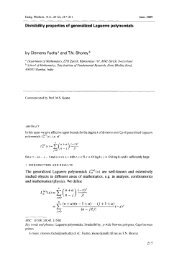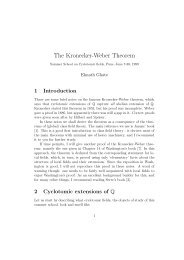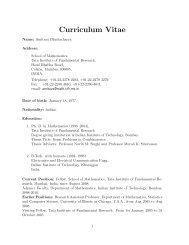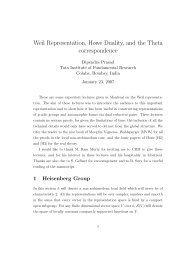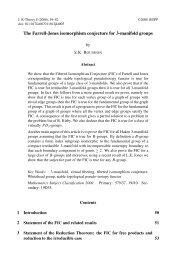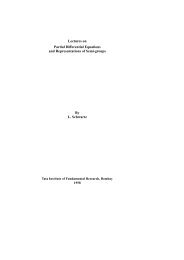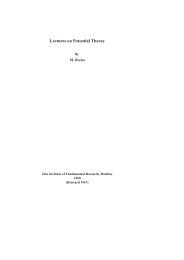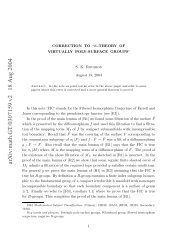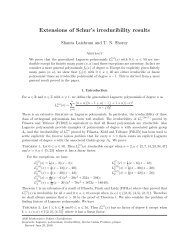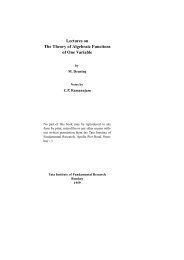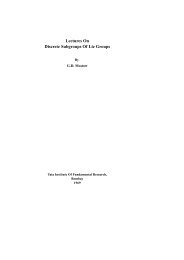On values of linear and quadratic forms at integral points
On values of linear and quadratic forms at integral points
On values of linear and quadratic forms at integral points
You also want an ePaper? Increase the reach of your titles
YUMPU automatically turns print PDFs into web optimized ePapers that Google loves.
9 Comments in conclusionThe study <strong>of</strong> flows on SL(n, IR)/SL(n, Z), <strong>and</strong> other more general homogeneousspaces <strong>of</strong> Lie groups, is also applied to various other Diophantineproblems. The reader is referred to [7] for an exposition <strong>of</strong> the general theory<strong>of</strong> flows on homogeneous spaces as well as various applic<strong>at</strong>ions. We mentionhere a only couple <strong>of</strong> recent applic<strong>at</strong>ions <strong>of</strong> the theory to certain Diophantineproblems. In [13] the authors study the asymptotics <strong>of</strong> the number <strong>of</strong> <strong>integral</strong><strong>points</strong> on certain subvarieties, within distance r <strong>of</strong> the origin, as r → ∞.In particular they obtain the following result, which may be <strong>of</strong> independentinterest.Theorem 9.1 (Eskin, Mozes <strong>and</strong> Shah). Let P be a monic polynomialwith <strong>integral</strong> coefficients which is irreducible over the r<strong>at</strong>ionals <strong>and</strong> has degree<strong>at</strong> least two. For r > 0 let N r be the number <strong>of</strong> <strong>integral</strong> n × n m<strong>at</strong>ricesX = (x ij ) with Σ i,j x 2 ij ≤ r 2 , whose characteristic polynomial is P . Thenthere exists a constant c > 0 such th<strong>at</strong> N r ∼ cr n(n−1)/2 as r → ∞.Interesting results have also been proved recently on ‘approximabilityproperties’ for <strong>linear</strong> <strong>forms</strong> <strong>and</strong> vectors in [18] <strong>and</strong> [16]. In the former aconjecture <strong>of</strong> Sprindzuk is verified <strong>and</strong> in the l<strong>at</strong>ter the theory <strong>of</strong> badly approximable<strong>and</strong> singular systems <strong>of</strong> <strong>linear</strong> <strong>forms</strong> is generalised.Acknowledgement: The author would like to thank Nimish Shah for his valuablecomments on an earlier version <strong>of</strong> the article.References[1] A. Borel <strong>and</strong> G. Prasad, Values <strong>of</strong> isotropic <strong>quadr<strong>at</strong>ic</strong> <strong>forms</strong> <strong>at</strong> S-<strong>integral</strong><strong>points</strong>, Compositio M<strong>at</strong>h. 83 (1992), 347-372.[2] J.W.S. Cassels, An Introduction to Diophantine approxim<strong>at</strong>ion, CambridgeUniversity Press, 1957.[3] J.W.S. Cassels, An Introduction to Geometry <strong>of</strong> Numbers, Springer-Verlag, 1959.[4] S.G. Dani, Approaching new <strong>points</strong> by applic<strong>at</strong>ion <strong>of</strong> <strong>linear</strong> transform<strong>at</strong>ions,Current Science, 56 (1987), 507-513.16



